The fourth of July means many things, and for photographers, one of the most exciting and challenging aspects of this holiday is capturing amazing photos of fireworks. The bright lights in the night paint the sky with multi-colored flames in a way that can be spectacular to witness and capture with your camera. And while it may seem that fireworks–and articles about how to capture fireworks with your DSLR–only appear for a few nights in early July, there are actually tons of nights from coast to coast all summer long when the skies are illuminated with fireworks.
We’re going to explore the ways to ensure sharp shots of these colorful subjects, along with some other ideas for nocturnal bright-light photography, and we’ll also offer up some pointers for tracking down upcoming fireworks displays, for the Fourth, and all summer long!
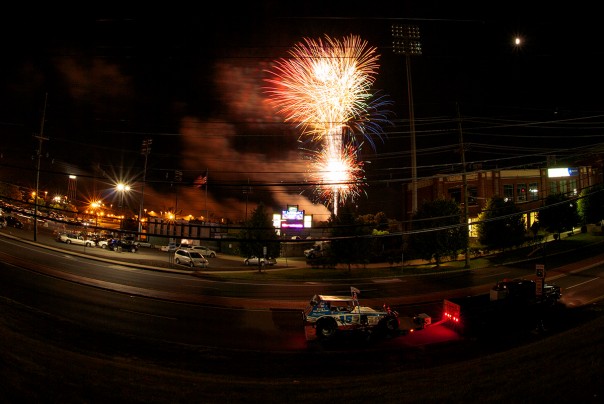
The first thing you need is a stable tripod!
For sharp shots of fireworks, you’re going to want a tripod–a stable tripod with three strong legs to keep your camera and lens still during the long exposures. And be sure to choose a location with firm ground! Boardwalks for example, have a lot of flex and bounce, and in a longer exposure, this will lead to blurriness in the frames. If you’re setting up on sand, protect your tripod legs inside plastic bags, and hang a camera bag or other weight from the center column to keep it from shifting on the sand during exposures.
And also remember to be considerate of fellow fireworks watchers–don’t set up a big tripod rig in front of others who are just there to enjoy the show! And when possible, scout the location in advance and look for a good angle to add some foreground and background intrigue to the images. For example, it may be behind the main crowd on a big park lawn, it may be from across the water, or with amusement park rides or a landmark building framing the composition.
Choosing Lenses
Generally speaking, wider angles are going to work best for fireworks to capture all the action of both earth and sky from a relatively close distance. This means the wide setting on a wide-to-normal zoom like the 18-35mm F1.8 DC HSM | Art, or 24-35mm F2 DG HSM | Art, or multi-zoom lens, or a dedicated wide angle prime or zoom lens such as the Sigma 15mm F2.8 EX DG Fisheye, or the 8-16mm F4.5-5.6 DC HSM I used for many of the shots to illustrate the fireworks above the ballpark in this article. If you are shooting fireworks from a significant distance away (more than a mile or so away from the display, a longer focal length may be desirable to keep the framing tight, but there’s probably going to be some atmospheric issues impacting the images in these cases–haze and heat distortion, for example. Zooms offer a lot of versatility in framing as it is sometimes tough to determine in advance just how high in the sky the rockets will shoot.
Take Control of Your Camera!
If you want to make good fireworks photos, you must take control of your camera! Turn off as many automatic settings as possible. All these helpful auto settings that are designed to help make a good exposure in virtually any situation will flat-out sink your hopes of making a strong, sharp shot of a firework in full bloom against a dark sky.
The quick list
- Automatic Flash should be turned off.
- AUTO ISO should be turned off. Choose the slowest ISO setting offered on your DSLR.
- Automatic Exposure Compensation (if present) should be turned off.
- Autofocus should be turned off.
- All auto-exposure modes (Auto, Program, Shutter- or Aperture-priority, etc) should be avoided in favor of Manual Exposure.
- Focus your wide angle lens at infinity and stop down to around f/11 (as your starting point) for amazing depth of field.
- If you’ve got a cable release, you should use it.
- Consider using the Mirror Lock-Up function to keep mirror slap from shaking the camera.
- Bulb mode gives great creative control.
- Remove any UV or skylight filters
- Be prepared to work up the photos in post-production to make them really pop!
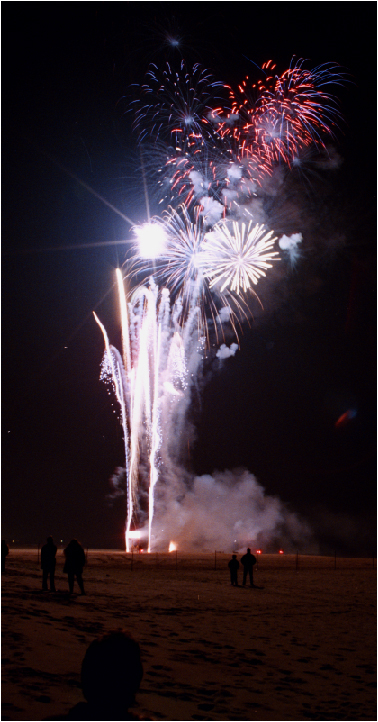
The why of the above
Auto Flash needs to be turned off because it will have no effect whatsoever on the exposure of the distant fireworks, and can potentially cause the camera to expose for the foreground subjects and not the fireworks, even in manual exposure mode. However, if you want to use fill-flash for foreground subjects, set your on-camera flash to second-curtain sync and dial back Flash Exposure Compensation at least -1 to – 1 ⅔ stop for the most pleasing blend of foreground light and background fireworks. There might be some ghost-motion subject due to the long exposure, but the flash will freeze and sharpen up the edges during the pop quite nicely.
AUTO ISO is going to see all the darkness in the frame before the fireworks burst and climb as high as it can to try to make a shorter exposure in that blackness. Then when the fireworks do light up the sky, the exposure will be both overblown, and very noisy due to the higher ISOs. Set your camera to its lowest ISO for the cleanest results.
Automatic Exposure Compensation, if present and activated, is going to try to “save you” from the mistake of having the manual metering set “wrong,” by reading the exposure at the moment you push the shutter and helping you fix it. For example as a rocket is launching, but not yet burst, a camera may determine that this darkscape needs a 10-second exposure at F/11, but a half-second later when the firework blooms, followed by another and another in that same 10-second shutter opening, it’s going to be a way too hot an exposure. So be sure to turn this off!
Turn off Autofocus! If you have autofocus active, it is going to hunt, search, and miss so many shots. You can either set your focus to infinity or set to the hyperfocal distance for your focal length and aperture and you will have the background fireworks in focus each time you fire the shutter. And at an aperture between F/8 and F/16 you’ll have plenty of depth of field wiggle room.
Use Manual Exposure, Check your Histograms, and adjust accordingly! For starters, try setting your camera to one second at F/11 at the lowest ISO to capture a single firework in full burst and fire the shutter just as it pops. Then be sure to check your LCD and histogram and adjust your aperture and shutter speed as necessary. If the firework is too bright in the frame, stop down to F/14 or F/16. Too dim? Open up to F/8. And If you want to capture several bursts in a single frame, you can stop down a little bit, and keep the shutter open for much longer. You may also want to try to shield the lens with a dark hat between fireworks bursts during long exposures. Fireworks do vary in overall intensity, and some frames may be blown out, and some others underexposed. Be sure to shoot a lot in order to bring home some winners!
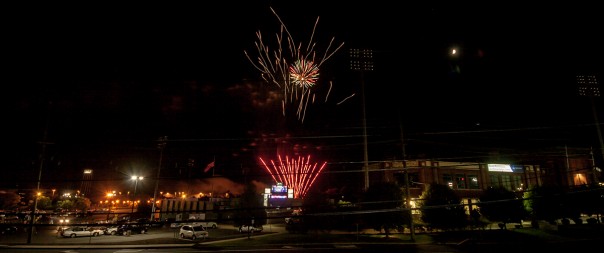
Consider a cable release and mirror lock-up. Most DSLRs have a mirror lock-up function for long exposures which can be switched on to eliminate camera shake from the mirror slapping up and down during capture. Once you’ve framed your scene, it’s easy enough to watch the fireworks and trigger the shutter without looking through the viewfinder, either from the on-camera shutter button, or via a cable release, which also limits any unintended camera movement during capture. But do get comfortable with mirror lock-up on your camera. And be aware that for many models, it is a two-touch process. The first shutter push locks the mirror, and the second opens the shutter.
And you should seriously consider BULB shooting mode. This is a special setting where the camera shutter is held open for as long as the shutter button is depressed. BULB mode capture is easier with a locking-button cable release. But is also possible using the on-camera shutter button–but be gentle to avoid camera shake at the start and finish of the shot when moving your hands and trigger finger! The beauty of BULB mode is that you can close the shutter when you choose, so if there’s a lot of low-intensity flares going on, you can hold the shutter open and have these “paint” the sky with their motion. But if there’s a couple of super-hot fireballs up next, you can just lift your finger and end the shot once these light up the sky without burning out to pure burnt whites in the center of the bursts. (And note that on some cameras, it is a special mode, and and others, it is a click past the longest programmable shutter speed–check your manual.)
Remove any UV or skylight filters! These front-of-lens filters certainly have their place, but for fireworks and other situations when you’ve got really bright objects against a lot of darkness, there’s a big possibility of adding ghost and flare artifacts to your images.
Got all that? Now it’s showtime!
Once the fireworks start, take a couple of test shots, and adjust accordingly. You may want to go to a longer time exposure to get a few more bursts in the frame, and if your frames are too light and too dark, you’ll want to adjust your aperture to fix the exposures. But do remember to review your on-camera histograms from time to time, especially as the show heats up and bigger, brighter displays are fired. And for the finale, when it’s a world of bursts, you’ll probably want to both stop down a bit and go with shorter shutter speeds.
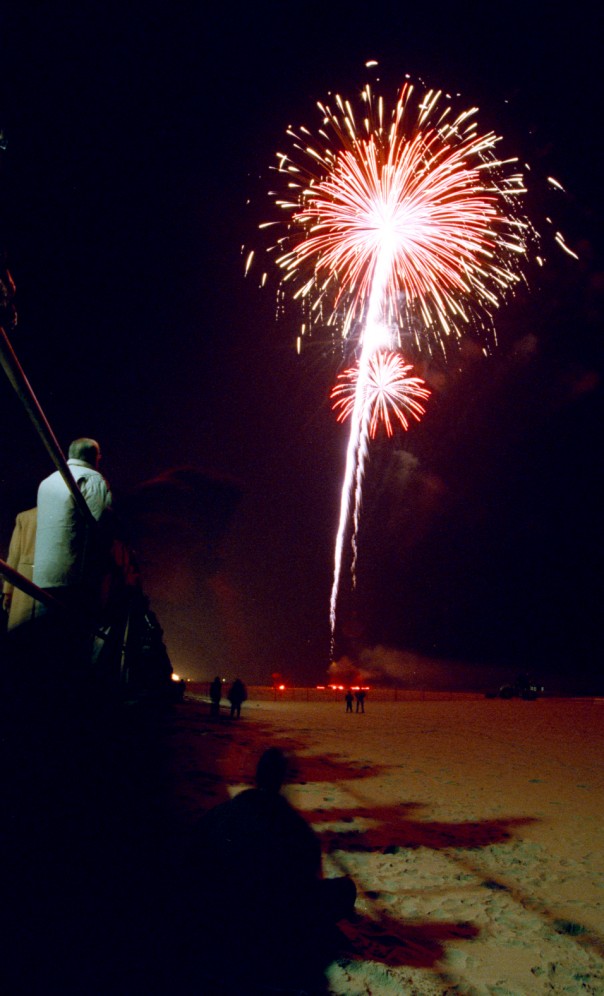
And you might want experiment with longer exposures to capture more bursts in a frame, or with shorter shutter speeds to make a series of frames to be animated in any of a dozen slideshow and video programs.
The most important thing to remember is to enjoy the experience, practice, learn how to set the camera to give you the best odds of nailing winning shots, and fire away again and again, adjust as necessary and fire again!
Fireworks Beyond the Fourth!
The Fourth of July is a hot night for fireworks, for sure, but in reality, there are tons of chances to make fireworks photos all summer long. Theme Parks, Beachfront and Boardwalks, Minor League Baseball, County Fairs are just a few of the spots you’ll likely find a chance to shoot fireworks this summer. Do a little searching online and you’ll find amazing spots to make firework shots!
For example, in Wildwood NJ, there are Fireworks over Morey Piers each and every Friday. And in Point Pleasant Beach, NJ, Jenkinson’s light up the night every single Thursday all summer long. And up in Coney Island, there’s fireworks every friday night along with a whole fireworks week at the Cyclone’s ballpark. And the Somerset Patriots, in Bridgewater NJ, where many of the shots for this blog were made, have frequent fireworks nights. Are you getting the big picture? Small-time baseball stadiums are a great source of fireworks! And with hundreds of teams across North America, that’s a lot of chances for capturing fireworks after a ballgame!
Montreal, Quebec, hosts the International Fireworks Festival on Saturdays throughout the summer, and there’s Fireworks every Friday on Hawaii at the Hilton Hawaiian Village. Here’s what’s happening in Philly.
And here’s a mega-listing of fireworks displays for the whole world.
Themed Festivals, State Fairs and Church Carnivals almost always have a fireworks night, and there’s hundreds upon hundreds of local milestones and celebrations marked with Fireworks. Search the web, check out tourism and travel sites, local entertainment guides, and you’ll likely find some cool fireworks displays to shoot!
More Nights and Lights Ideas
The same basic tips for fireworks photography also work well for many other nocturnal photo projects. For example, use the same basic settings and you can turn fast-moving car head and tail lights into ribbons of color along the roadway, or capture the light-tracing arcs of amusement park rides in motion. And of course, distant lightning is always a spectacular subject, although it does come with a degree of risk. And either alone, or in conjunction with other lights in the night, you can always take an active role and paint the darkness with LED flashlights and other light-up gadgets for cool, creative effects.
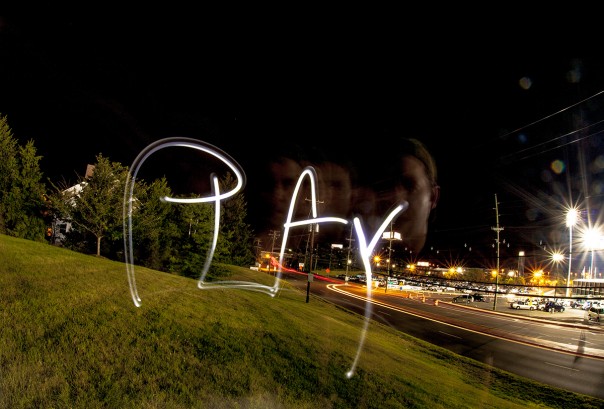
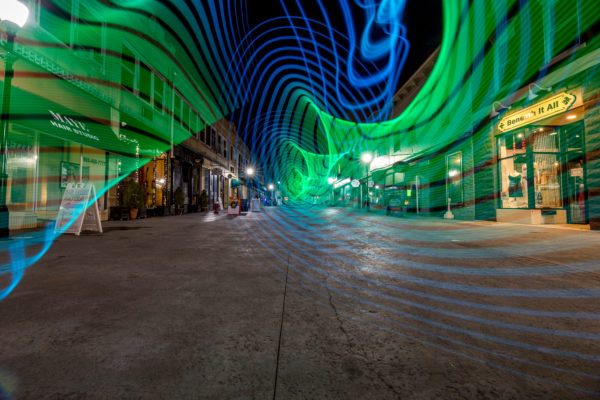
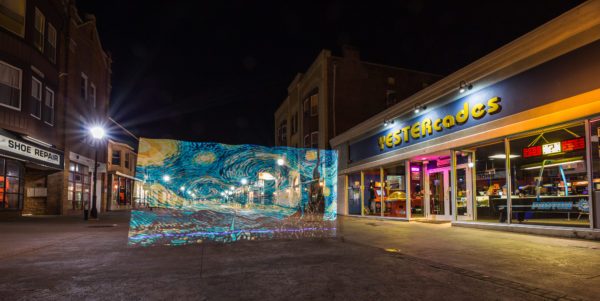
The most important thing to remember when practicing and experimenting with new photographic techniques is to keep learning, keep experimenting, and keep discovering. You may have some winning frames, and you may have a bunch of flops, but you can learn from those flops and refine your techniques and settings, and get stronger each time you head out into the night to capture bright lights.

I got some great shots handheld, or rather lap held. The fireworks were booming pretty much straight above us and I would just hold it right in my lap rock-solid and shot with a wide-angle lens. hold open the lens until the explosion happened. it was actually a fairly windy day and got some really beautiful shots of kind of feathery looking stuff streaming off to the side in the wind.
Nice tips… easy to understand. I am ready for tonight for sure, now!
i enjoyed this article! I have used tripod but as in many other situations, a tripod can inhibit your ability ti get unpredictable shots. Monopods are good but for really long bulb shots may become ineffective. I would encourage those who’ve got a little resistance to tripod use (for whatever reason) to go ahead and shoot handheld BULB shots. Tighter aperture gives thinner trails… without sturdy support, you WILL encounter wiggly trails which CAN add interest to composite pictures. i began shooting fireworks with Kodachrome 25 and 64 with my dad as a young teen. just anticipate burst and put hand or cap over lens and mentally track each spark and position within frame. Options unlimited!
What setting should my white balance be at for the best fire works display shots?
Shula, I’d try Daylight WB, but shoot in RAW for flexibility to change it as needed in RAW processing.
I find that 1/30s at ISOs 800+ works for me. Good balance between capture and avoiding dragging streaks from long exposures. Plenty of examples:
http://alphawhiskey.slickpic.com/a/Fireworks?squared
http://alphawhiskey.slickpic.com/photoblog/post/NovemberFireworks
I find 1/30s at ISOs 800+ works for me. Avoids the drags and streaks from long exposures and still gets the full expression of the fireworks. Plenty of examples:
http://alphawhiskey.slickpic.com/a/Fireworks?squared
http://alphawhiskey.slickpic.com/photoblog/post/NovemberFireworks
I am a big fan of bulb and using a dark baseball hat to cover the lens intermitently. Especially in the early part of the show when the shells are spaced out a bit in most displays. Keeps the trails of light from getting too long and combining multie shells into one frame makes for more interesting combinations. Also, pay attention to the direction of the wind so you aren’t having to shoot through all the smoke if you can avoid it.